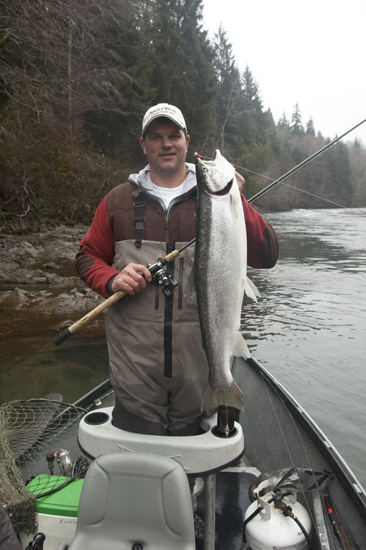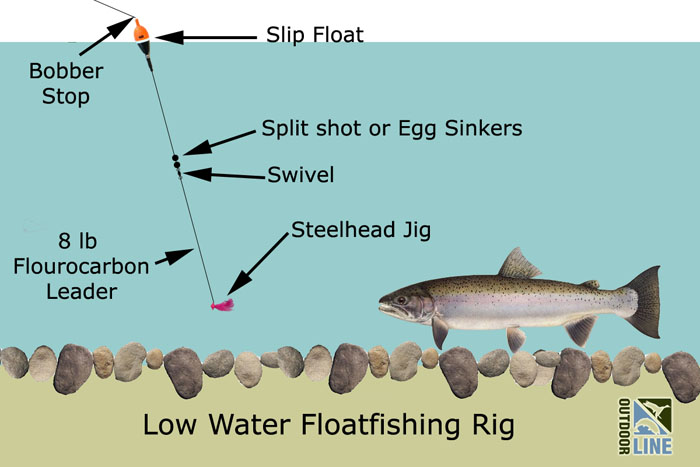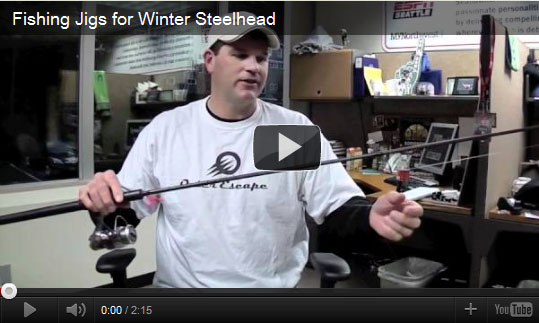Rigging a Slip Float for Low Water Winter Steelhead 3
We're in the middle of our second La Nina winter in a row here in Washington and the weather maelstrom that many of the meteorologists predicted, well, it hasn't materialized yet. Knock on wood!
This has been the driest December on record and that's dropped many of the cricks in Western Washington to near summer lows, which means you've got to switch tactics a little to tickle the fancy of a winter steelhead and get them to bite. One of the deadliest techniques for bagging these low water steelhead is fishing with a jig and a slip float.

I like to use a 9'6" to 10'6" light drift or spinning rod that has a slow action to cushion my 8 or 10 pound test Seaguar flourocarbon leader. For mainline I like to run 10 to 12 pound monofilament and if you like to run braided line tie in an eight to ten foot bumper of monofilament onto the business end of the braid. That bumper of mono allows small slip floats to slide up and down the line more easily.
In the winter months you can get away with a 1/2 to 3/4 ounce slip float and there are many excellent brands out there. Steelhead Stalker, Cleardrift, Thill, and Danielson all make great slip floats for low water winter steelhead fishing. I use a lot of the Danielson's because they are easy on my pocket book, but in reeeeeally low water it's tough to beat the Cleardrift slip float. At seven bucks apiece they are spendy, but well worth it if you need to be super sneaky. In summer months you may need to use a much smaller float and you can tweak your setup accordingly.
You're going to add a bobber stop to the mainline above the slip float and then slide on a small bead to keep the knot from passing thru the center of the float. I like the knot-style bobber stops because I can see them and know when my knot is right down on the float, meaning my jig is down there it needs to be. Below the slip float use either split shot or egg sinkers to weight down the float and keep your jig in the hammer zone, then tie in a small swivel between the mainline and leader.
Attach two to three feet of 8 or 10 pound test Seaguar flourocarbon leader to the swivel and finish it all off with a 1/8th to 1/4 ounce jig. For steelhead I never fish a jig larger than 1/4 ounce and I rarely go below an 1/8th ounce jig in the winter months, although a 1/6th ounce jig will sometimes produce when nothing else does. Just ask Ryan, who bagged his limit of steelhead on the Skykomish River last weekend on a 1/16th ounce jig while listening to the Outdoor Line on his cell phone. Here's his report in the Outdoor Line Fishing Reports Forum. Nice work man!
The key to this whole floatfishing set up is to have just enough weight so that roughly 3/4 of the float is underwater. Set your jig so that it's within a foot, or so, of the bottom and for the ultimate presentation hold back on the float slightly as it's drifting thru juicy steelhead holding water. The water on the bottom of the river is actually slower than it is on the surface and this keeps your jig below the float where it needs to be.
A great jig color to start with is pink and white, but other kick ass colors include pink/purple, the Nightmare pattern, red/black, peach/white, cerise/chartruese, and cerise.
Lastly, tip your jig with a small piece of prawn meat for the ultimate hammer time action. Steelhead will hit a jig without it, but when things get tough a little prawn meat will coax'em into biting. The 50 to 60 count prawns you find at your local grocery store work great for this.

If you're into the whole video thang check out one of the Outdoor Line videos that I posted a couple weeks back describing how to rig up a float for winter steelheading. Here's that video and there's a whole lot more where that came from on the Outdoor Line Video Page.
You're now ready to hit one of our super low rivers and schwack-out some dime bright winter steelhead. This is definitely a basic floatfishing rig and this set up can be tweaked any number of ways to suit your needs. You can certainly get a whole lot lighter than this with some of the light rods, lines, and floats on the market nowadays. Don't be afraid to share some of your floatfishing strategies on the Outdoor Line Forums. It's where all the cool kids are hanging out!
Rob Endsley
The Outdoor Line
710 ESPN Seattle
www.theoutdoorline.com



hi I was just wondering what mono are you using for steelhead bobber and jig or eggs thank you very much for your information Mime
Are Danielson drift floats the same exact thing as the "West coast floats" brand. They sure look exactly the same but a bit less cost. I'd assume West Coast Floats makes them "for" Danielson Oiutdoors.
Kathy just asked me why you were "standing in a toilet" in that first pic. Since I'm still trying to talk her into floating down a river in the drift boat, I'm not going to tell her just yet that drift boats don't have built in plumbing...:)